Frank ICSE Solutions for Class 9 Physics – Fluids
PAGE NO: 157
Solution 1:
The thrust on the unit surface is known as pressure. The SI unit of pressure is Nm-2.
Solution 2:
Pressure is given by
P = h Xp Xg.
Where h is height of liquid column, p is density of liquid, g is acceleration due to gravity.
Density of mercury is = 1.36 x 104 kg/m3.
h= height of mercury column which is given = 75 cm = 0.75 m.
So pressure = 0.75 x 1.36 x 104 x 9.8 = 9.996 x 104Nm-2.
Solution 3:
Pressure is a scalar physical quantity.
Solution 4:
One pascal is defined as the pressure exerted on a surface of area 1 m2 by a force of 1 Newton acting normally on the surface.
Solution 5:
The force acting normally on a surface is known as thrust.
SI unit of thrust is N.
Solution 6:

Solution 7:
Water can’t be used in place of mercury in a barometer because of its low density. It would require 10.34 m long tube to measure 1 atmospheric pressure which is not practically possible while mercury having high density (13.6 g/cc) would require only 0.76 m long pipe which is practically possible.
Solution 8:
Pressure is the physical quantity which is measured in bar.
Solution 9:
Thrust is a vector quantity.
Solution 10:
Thrust on a surface is the force acting normally on a surface while pressure on a surface is thrust acting on the unit area of a surface.
Solution 11:

Solution 12:
Lake has greater pressure at the bottom than the surface as pressure increases with depth. So when gas bubble is released at the bottom of the lake it experiences more pressure and is small in size but as it rises upwards the pressure experienced by it decreases. So it grows in size as it moves towards the surface from bottom.
Solution 13:
A dam has broader walls at the bottom than at the top because the pressure exerted by a liquid increases with its depth, and at any point at a particular depth liquid pressure is same in all directions. Now as more pressure is exerted by water on the wall of the dam as depth increases. Hence a thick wall is constructed at the bottom of dam to withstand greater pressure.
Solution 14:
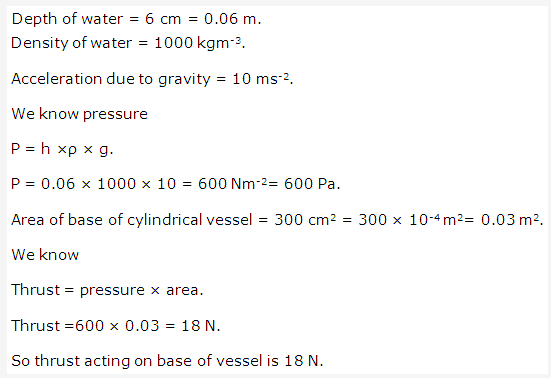
Solution 15:
The pressure at a point in a liquid depends upon on the following three factors:
- It depends on the point below the free surface (h).
- It depends on density of liquid (p).
- It depends upon acceleration due to gravity (g) of the place.
Solution 16:

Solution 17:
A substance having a tendency to flow is called fluid.
A fluid exerts pressure on the bottom due to its weight and on the walls of the container in which it is enclosed by virtue of its ability to flow. This is called fluid pressure.
Solution 18:
The laws of liquid pressure are
- Pressure inside the liquid increases with the depth from the free surface of the liquid.
- Pressure is same at all points on a horizontal plane, in case of a stationary liquid.
- Pressure is same in all directions about a point inside the liquid.
- Pressure at same depth is different in different liquids. It increases with the increase in the density of the liquid.
- A liquid will always seek its own level.
Solution 19:

Solution 20:
A diving suit is a garment or device designed to protect a diver from the underwater environment.
Solution 21:
There are five main types of ambient pressure suits. These are wetsuits, drysuits, semidry suits, dive skins etc.
Solution 22:
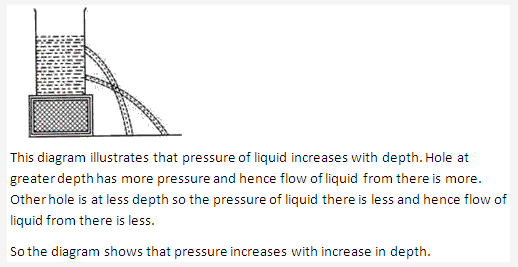
Solution 23:
Manometer is a simple pressure gauge that measures differences in pressure at the two ends of the apparatus.
Manometer is a U shaped tube containing water whose one limb is dipped in vessel and vessel is tightly covered with plastic sheet. U shaped tube has two limbs one towards the vessel and other is opened to atmosphere.
Now if level of water toward atmospheric open limb is more than level of water in limb towards apparatus end then liquid is said to be at higher pressure than atmosphere. And if level of water toward atmospheric open limb is less than level of water in limb towards apparatus end then liquid is said to be at lower pressure than atmospheric pressure.
PAGE NO : 158
Solution 24:
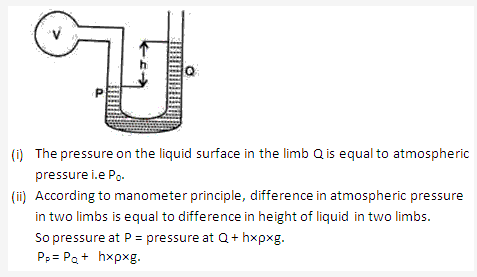
Solution 25:
A hydraulic press works on the principle of pascal’s law. A hydraulic press can be used for extracting juice of sugarcane, sugar beet etc.
Solution 28:
Pascal’s law states that pressure applied to an enclosed liquid, is transmitted equally to every part of the liquid or in other words when pressure is applied at a point in a confined fluid, it is transmitted undiminished and equally in all directions throughout the liquid.
Hydraulic machines such as hydraulic press, hydraulic brakes and hydraulic jack are application of pascal’s law.
Solution 29:
Altimeter is a device which is used in an aircraft to measure its altitude.
Solution 30:
Atmospheric pressure decreases with increase in height. our atmosphere comprises of a large number of parallel layers. The pressure on a layer is equal to the thrust or weight of the gaseous column on the unit area of that layer. Hence, as we go up, the weight of the gaseous column decreases, which decrease the pressure of the gaseous column.
Solution 31:
Aneroid means containing no liquid and aneroid barometer is evacuated so it tends to collapse under the pressure of air. The stout spring balances the thrust on the metal box due to normal air pressure and prevents the box from collapsing. As this type of barometer doesn’t contain any liquid so it got its name aneroid barometer.
Solution 32:
Barometer is a device which is used for measuring atmospheric pressure. Barometers are used in weather forecasting and in measuring altitudes.
Solution 33:
Mercury is used in barometer because
- It can be obtained in pure form.
- It does not vaporizeat ordinary temperatures.
- Its density is high and hence the length of the mercury column supported by atmospheric pressure is 76 cm which is practically possible.
PAGE NO: 173
Solution 1:
All liquid exerts an upward force on the body placed in it. This Phenomenon is called buoyancy.
Solution 2:
The upward force which any liquid exerts upon a body placed in it is called the upthrust. The SI unit of upthrust is N.
Solution 3:
Buoyant force act on a body in upward direction.
Solution 4:
Upthrust is defined as the upward force on the object provided by the liquid because the object has displaced some of the fluid.
Solution 5:
When block of cork is immersed in water buoyant force acts on it in upward direction so to overcome this force we have to apply an equal force in downward direction to keep block of cork inside water.
Solution 6:
Wood has density less than water so volume of water displaced by it is more than the volume of wooden block submerged so force of upthrust is greater than the weight of wood which pushes wooden block on the surface. Hence, a piece of wood when left under water again comes to the surface.
Solution 7:
A body will weigh more in air as weight of body acts in downward direction and there is no force in upward direction while body submerged in water weigh less because an upthrust act on the body in upward direction so the resultant weight of the body decreases.
Solution 8:
Upthrust or buoyant force depends on the following factors:
- Volume of body submerged in the liquid.
- Density of the liquid.
- Acceleration due to gravity.
Solution 9:
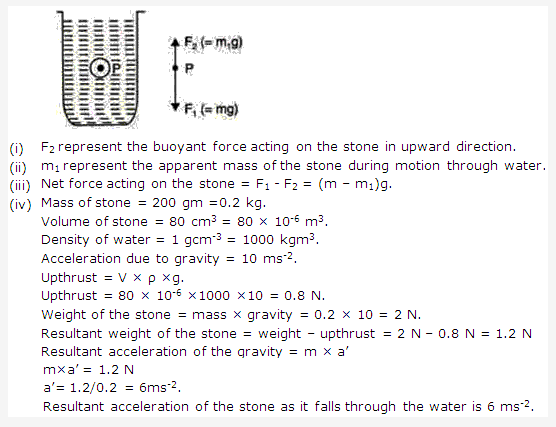
Solution 10:
Weight of the body in air = 300 gf.
Apparent Weight of the completely immersed body in water = 280 gf.
- Loss in weight of the body = Weight of body in air – apparent weight of immersed body.
Loss in weight = 300 gf – -280 gf = 20 gf. - As upthrust on the body = loss in weight
- So uptrust = 20 gf.
Solution 11:
Edge of metal cube = 5 cm.
Density of the metal cube = 9 gcm-3 = 9 x 103 kgm-3.
Volume of the metal cube = 125 cm3 = 125 x 10-6 m3.
Mass of the metal cube =9 x 103 x 125 x 10-6 = 1125 x 10-3 =1.125 kg.
Weight of the liquid = mass x gravity = 1.125 x 10 = 11.25 N.
Density of liquid = 1.2 gcm-3= 1.2 x 103 kgm-3.
Upthrust of the liquid = V Xp Xg.
Upthrust = 125 x 10-6 x 1.2 x 103 x 10 = 1.5 N.
Apparent weight of the body = weight of liquid – upthrust
Apparent weight = 11.25 N – 1.5 N = 9.75 N
Tension in the string is equal to the apparent weight of the body
So, tension in string would be 9.75 N.
Solution 12:
It is easier to lift a heavy stone under water because in water an upthrust acts on the upward direction which reduces the apparent weight of the stone and makes it easy to lift.
Solution 13:
Principle of Archimedes’ states that when a body is totally or partially immersed in a fluid, it experiences an upthrust equal to the weight of the fluid displaced by it.
Solution 14:

Solution 15:

PAGE NO : 174
Solution 16:
Wood has density less than water so volume of water displaced by it is more than the volume of wooden block submerged so force of upthrust is greater than the weight of wood which makes it float on the water surface. And the apparent weight of the piece of the wood would be zero.
Solution 17:
Density of iron is less than the density of mercury so it will float on the surface of the mercury. Apparent weight of the floating iron ball is zero.
Solution 18:
Iron nail has density less than that of mercury so it will float on the surface of mercury but in the case of water it will sink because the density of iron nail is more than that of water.
Solution 19:
No, the relative density of a substance is the ratio of the density of the substance to the density of water at 40C.
Solution 20:
- SI unit of buoyant force is N.
- SI unit of density is Kgm-3.
- SI unit of weight of body is N.
- Relative density is a pure ratio it has no dimension.
Solution 21:
Density of iron is more than the density of water so it sinks down in the water but in case of ship, it is design in such a manner that it encloses large quantity of air in air tight bags and in rooms and corridors which makes the average density of ship less than that of water and ship floats on the surface of the water.
Solution 22:
The fractional part submerged equals the ratio of the density of the material of the block to the density of the liquid.
(Density of floating body / Density of liquid) = fraction submerged.
The Fraction of ice submerged in water remain same as density of ice and water remain same during melting. As ice melts some volume of ice decrease and convert into water and volume of water increase by same amount. So, level of water remains same during melting.
Solution 23:
The fractional part submerged equals the ratio of the density of the material of the block to the density of the liquid.
(Density of floating body / Density of liquid) = fraction submerged.
Height of wooden piece = 15 cm.
Height of wooden piece sinks in water = 10 cm.
Fraction of wooden piece submerged in water = 10/15 = 0.67.
As liquid is water so ratio of Density of wooden by density of water gives relative density of floating wooden piece. So, relative density of wooden block is 0.67.
Height of wooden piece = 15 cm.
Height of wooden piece sinks in spirit = 12 cm.
Fraction of wooden piece submerged in water = 12/15 = 0.8.
We know density of wooden piece = 0.67
(Density of floating body / Density of liquid) = fraction submerged.
Density of liquid/spirit = (Density of floating body /fraction submerged)
Density of liquid/spirit = 0.67/0.8 = 0.83.
Relative density of spirit is 0.83.
Solution 24:
- When a body is completely immersed in water then it displaces equal volume of water to its own weight. Volume of body of man is same in both river and sea so weight of water of sea displaced by him is equal to the weight of water of river displaced by him. And ratio of weights would be 1:1.
- Sea water contains mineral salts and density of sea water increase due to presence of these. As density of sea water is more than the normal water so it apply more buoyant force than usual one and a person find it easy to swim in sea water.
Solution 25:
The fractional part submerged equals the ratio of the density of the material of the block to the density of the liquid.
(Density of floating body / Density of liquid) = fraction submerged.
Fraction of wooden piece submerged in water = 2/3 = 0.67.
As liquid is water so ratio of Density of wooden by density of water gives relative density of floating wooden piece.
So, relative density of wooden block is 0.67.
Density of water in SI system = 1000 Kg m-3.
Density of wood=relative density x density of water =0.67 x 1000 Kg m-3 =670 kgm.
Fraction of wooden piece submerged in oil = 3/4 = 0.75.
We know density of wooden piece = 0.67
(Density of floating body / Density of liquid) = fraction submerged.
Relative Density of oil = (Relative Density of wooden block/fraction submerged)
Density of oil = 0.67/0.75 = 0.893.
Density of water in SI system = 1000 Kg m-3.
Density of oil =relative density x density of water =0.893 x 1000 Kg m-3 =893 kgm-3.
Solution 26:
Relative density of Ice = 0.92
Relative density of sea water = 1.025
Let total volume of iceberg = X cm3.
Volume of iceberg above water = 800 cm3.
Volume of iceberg in submerged in the water = (X – 800) cm3.
Fraction of iceberg submerged = (X- 800)/X
Now we know that fractional part submerged equals the ratio of the density of the material of the block to the density of the liquid.
(Density of ice / Density of sea water) = fraction submerged
0.92/1.025 = (X-800)/X
0.8975 X = X – 800
X – 0.8975 X = 800
0.1025 X = 800
X = 800/0.1025 = 7804.8 cm3.
Total volume of iceberg = 7804.8 cm3.
Solution 27:
Relative density of wax = 0.95
Relative density of brine = 1.1
(Density of wax/ Density of brine) = fraction submerged
0.95/1.1 = fraction of volume submerged
Fraction of volume submerged = 0.86
Solution 28:
Relative density of Ice = 0.9 cm
Relative density of sea water = 1.1 cm
(Density of ice / Density of sea water) = fraction submerged of iceberg
0.9/1.1 = fraction of iceberg submerged
Fraction of iceberg submerged = 9/11.
Solution 30:
Lactometer is commonly used for testing the purity of milk.
Solution 31:
Density of water at 40c in SI system is = 1000 Kgm-3.
Solution 32:
Side of wooden cube = 10 cm.
Volume of wooden cube = 10 x 10 x 10 = 1000 cm3.
Mass of wooden cube = 700 g.
Density of wooden cube = mass/volume = 700/1000 = 0.7 gcm-3.
Density of water = 1 gcm-3.
(Density of floating body / Density of liquid) = fraction submerged
0.7/1 =fraction submerged
Fraction of wooden cube submerged in water = 0.7
Height of wooden cube = 10 cm
Part of wooden cube which is submerged = 10 x 0.7 = 7 cm
So, wooden cube will float in water with 3 cm height above the water surface.
Solution 33:
Volume of wooden block = 0.032 m3.
Mass of wooden block = 24 Kg.
Density of wooden block = mass/volume = 24/0.032 = 750 Kgm-3.
Density of water = 1000 Kgm-3.
(Density of floating body / Density of liquid) = fraction submerged
750/1000 =fraction submerged
Fraction of wooden block submerged in water = 0.75
Total volume of wooden block = 0.032 m3.
Part of volume of wooden block which is submerged = 0.032 x 0.75 = 0.024 m3.
Solution 34:
Relative density = density of substance /density of water at 40C.
As relative density of platinum is 21.50, this means platinum is 21.5 times denser than water at 40C.
PAGE NO : 175
Solution 35:
Density of mercury = 13600 Kgm-3.
Density of water at 40C = 1000 kg m-3.
Relative density = density of substance /density of water at 40C.
Relative density of mercury = 13600 Kgm-3/1000 kg m-3 = 13.6.
Solution 36:
volume of body = 100 cm3.
Weight of body = 1 kgf = 1000 gf
Mass of body= 1000 gm.
Density of liquid = 1000 gm/100cm3 = 10 gcm3.
Density of water at 4o = 1gcm-3.
Relative density = density of substance /density of water at 40 C
Relative density = 10 gcm3 /1 gcm3 = 10
Mass of body= 1000 gm.
Density of water = 1 gcm-3
Acceleration due to gravity = 10 ms-2.
Upthrust = V Xp Xg.
Upthrust = 100 x 1 gf = 100 gf.
Resultant weight of the body = weight – upthrust = 1000 gf – 100 gf = 900 gf.
Solution 37:
When a body is completely immersed in water then it displaces equal volume of water to its own weight.
So, volume of body = 20000 cm3.
Mass of body = 70 kg = 70000 gm
Density of body = mass /volume = 70000/20000= 3.5 gm cm-3.
Density of water in C.G.S system = 1g cm-3.
Relative density of body = density of body /density of water =3.5 gm cm-3/1g cm-3.
Relative density = 3.5.
Solution 38:
Relative density = density of mercury /density of water.
Density of mercury = relative density x density of water.
Relative density = 13.6.
Density of water in C.G.S system = 1g cm-3.
So, density of mercury in C.G.S system = 13.6 x 1 = 13.6 gcm-3.
Density of water in SI system = 1000 Kg m-3.
So, density of mercury in SI system = 13.6 x 1000 = 13.6 x 103 Kgcm-3.
Solution 39:
Density of iron is = 7.8 x 103 Kg m-3.
Density of water at 40C = 103 Kg m-3.
Relative density of a substance is the ratio of the density of the substance to the density of water at 40C.
So, relative density of iron is = 7.8 x 103 Kg m-3/103 Kg m-3 = 7.8
Solution 40:
- Mass of a metallic piece remains unchanged with increase in temperature.
- Volume of metallic piece increases with increase in temperature.
- Density of metallic piece decreases with increases in temperature.
Solution 41:
Density of water decreases with the increase in temperature and increases with decreases in temperature.
Solution 42:

PAGE NO: 177
Solution 1:
All liquid exerts a upward force on the body placed in it. This Phenomenon is called buoyancy.
Solution 2:
The upward force which any liquid exerts upon a body placed in it is called the upthrust.
Solution 3:
Pressure is a scalar quantity.
Solution 4:
Thrust is a vector quantity.
Solution 5:
SI unit of density is Kgm-3.
Solution 6:
The relative density of a substance is the ratio of the density of the substance to the density of water at 40C.
Solution 7:

Solution 8:
Principle of Archimedes’ states that when a body is totally or partially immersed in a fluid, it experiences an upthrust equal to the weight of the fluid displaced. Yes, it applies to gases also.
Solution 9:
Thrust on a surface is the force acting normally on a surface while pressure on a surface is thrust acting on the unit area of a surface.
Solution 10:
Pascal’s law states that pressure applied to an enclosed liquid, is transmitted equally to every part of the liquid or in other words when pressure is applied at a point in a confined fluid, it is transmitted undiminished and equally in all directions throughout the liquid.
Solution 11:
Yes, all liquid exert pressure.
Solution 12:
Hydraulic machines such as hydraulic press, hydraulic brakes and hydraulic jack are application of pascal’s law.
Solution 13:
Pascal’s law is principle of hydraulic machines.
Solution 14:
Brahma press depends upon Pascal’s law.
Solution 15:
- A hydraulic press can be used for extracting juice of sugarcane, sugar beet etc.
- A hydraulic press can be used for pressing cotton bales, quilts, books etc.
Solution 16:
Atmospheric point at any point in air at rest is equal to the weight of a vertical column of air on a unit area surrounding the point, the column extending to the top of atmosphere.
Solution 17:
Atmospheric pressure at sea level is about 105 N/m2.
Solution 18:
Barometer is used for measuring the atmospheric pressure.
Solution 19:
Altimeter is a device which is used in an aircraft to measure its altitude.
Solution 20:
A falling barometer indicates the approach of rain or storm or both.
PAGE NO : 178
Solution 21:
A atmospheric pressure diving suit is a garment or device designed to protect a diver from the underwater environment. Yes, diving suits create buoyancy.
Solution 23:
A fluid exerts pressure on the bottom due to its weight and on the walls of the container in which it is enclosed by virtue of its ability to flow. This is called fluid pressure.
Solution 24:
A dam has broader walls at the bottom than at the top because the pressure exerted by a liquid increases with its depth, and at any point at a particular depth liquid pressure is same in all directions. Now as more pressure is exerted by water on the wall of the dam as depth increases. Hence a thick wall is constructed at the bottom of dam to withstand greater pressure.
Solution 25:
Pascal’s law states that pressure applied to an enclosed liquid, is transmitted equally to every part of the liquid.
Means when pressure is applied at a point in a confined fluid, it is transmitted undiminished and equally in all directions throughout the liquid.
Solution 27:
Factors which affect the atmospheric pressure as we go up are
- Weight of gaseous column.
- Density of gaseous column.
Solution 28:
Atmospheric pressure decreases with increase in height. Our atmosphere comprises of a large number of parallel layers. The pressure on a layer is equal to the thrust or weight of the gaseous column on the unit area of that layer. Hence, as we go up, the weight of the gaseous column decreases, which decrease the pressure of the gaseous column.
Solution 29:
Barometer is a device used for measuring atmospheric pressure.
Simple barometer has two main defects
- It is not suitable for making accurate measurement of atmospheric pressure as any change in the level of mercury in the tube changes the level of the free surface of mercury is trough and fixed scale cannot be used with it.
- Simple barometer is not portable. So, it cannot be used by airmen, navigators, mountaineers, who need a portable barometer.
Solution 31:
We don’t feel uneasy even under enormous pressure of the atmosphere above us because our blood also exerts a pressure called blood pressure, which is greater than atmospheric pressure. So, there is balance between our blood pressure and atmospheric pressure.
Solution 32:
Reading of a barometer would rise if it is taken to the mine as pressure increases with depth.
Reading of a barometer would fall if it is taken to a hill as pressure decreases with increase in height.
Solution 33:
Weight of solid in air = 2.10 N
Relative density of solid = 8.4
Now, Relative density = weight of solid in air/ loss of weight of solid in water.
Loss of weight of solid in water = weight of solid in air/ Relative density.
Loss of weight of solid in water = 2.10/8.4 = 0.25 N.
Weight of solid in water = weight in air – loss of weight in water
Weight of solid in water = 2.10 – 0.25 =1.85 N.
Relative density of liquid =1.2
We know
Relative density of liquid = Loss of weight of solid in liquid/loss of weight of solid in water.
Loss of weight of solid in liquid = Relative density x loss of weight of solid in water.
Loss of weight of solid in liquid = 1.2 x 0.25 = 0.3 N.
Weight of solid in liquid = weight of solid in air – loss of weight of solid in liquid.
Weight of solid in liquid = 2.10 – 0.3 = 1.8 N.
Solution 34:
Density of iron is 7800Kgm-3.
This means a cube of iron having side 1m would weigh 7800 Kg.
Density of water at 40C is 1000 Kgm-3.
Solution 35:
Relative density of body = 0.52
Density of water at 40C = 1000 Kgm-3.
Density of body = 0.52 x 1000 Kgm-3= 520 Kgm-3
We know density = mass x volume.
Mass = density x volume
Mass = 520 x 2 =1040 Kg.
Mass of given body is 1040 Kg.
Solution 36:
Piece of metal weighs in air = 44.5 f
Piece of metal weighs in liquid = 39.5 f.
Loss of weight of metal in liquid = 44.5 – 39.5 = 5f.
Relative density = weight of solid in air/ loss of weight of solid in water.
Relative density of liquid =44.5f/5f =8.9
Relative density of liquid = 8.9
Solution 37:
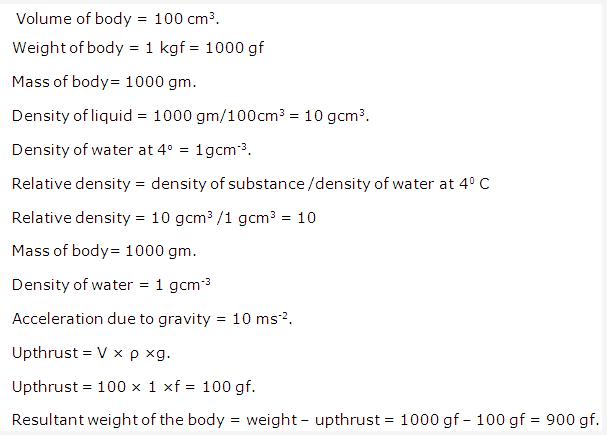
Solution 38:
Principle of floatation states that a floatating body displaces an amount of fluid equal to its own weight.
Ship is designed in such a manner that it encloses large quantity of air in air tight bags and in rooms and corridors which makes the average density of ship less than that of water.
Solution 40:
Acid battery hydrometer is used to check the concentration of sulphuric acid in an acid battery.
Solution 41:
Iron nail has density less than that of mercury so it will float on the surface of mercury but in the case of water it will sink because the density of iron nail is more than that of water.
Solution 43:
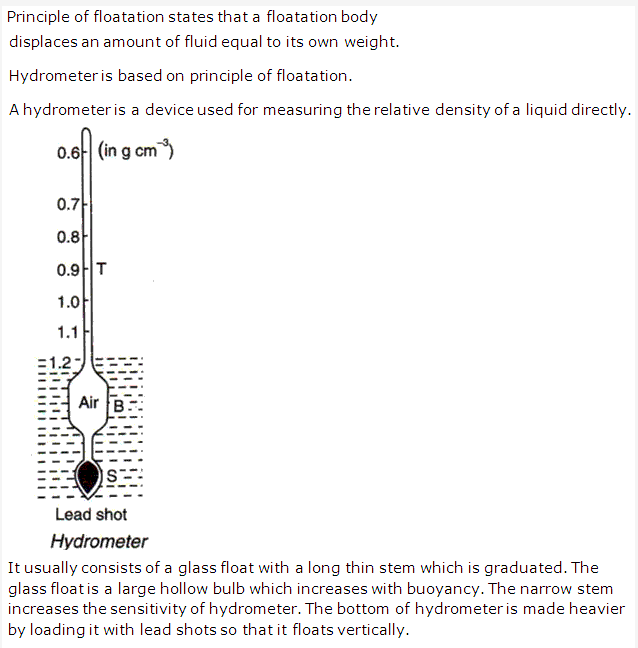
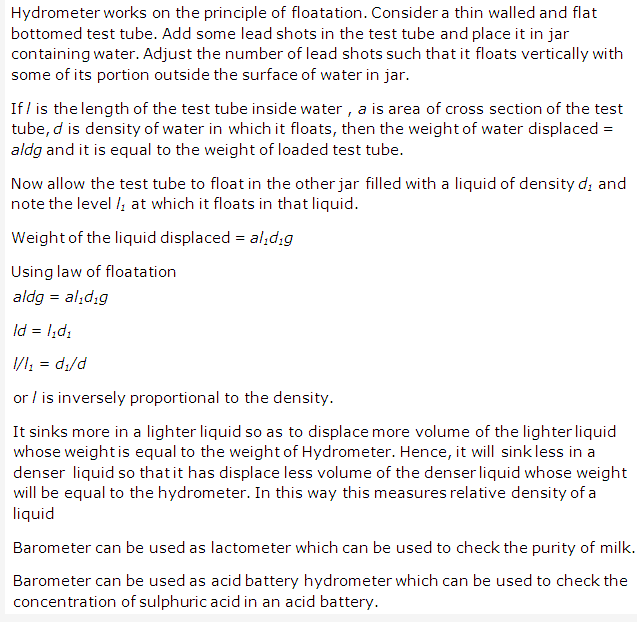
Solution 44:
- A balloon filled with hydrogen has low density than air so it rises over the air but as height increases density of air decreases and at a certain height the density of hydrogen in balloon and density of air become equal. And as there is no density difference there is no pressure difference also and hence balloon stops rising further.
- Density of egg is greater than fresh water so it sinks in fresh water but due to addition of salt density of water increases which makes the density of salt water greater than egg and hence floats in a strong solution of salt.
- The bottom of the hydrometer is made heavier by loading it with lead shots so that it floats vertically with some of its portion outside the surface of water in the jar.
- Relative density of Ice is = 0.9 cm-3
Relative density of sea water is = 1 cm-3
(Density of ice / Density of sea water) = fraction submerged of iceberg
0.9/1 = fraction of iceberg submerged
Fraction of iceberg submerged = 9/10.
Thus in colder countries where there are icebergs in oceans, only about 1/10 is seen above water and the remaining water 9/10 remain submerged. Hence, there is danger of these icebergs to the ships sailing in these oceans.
Solution 45:
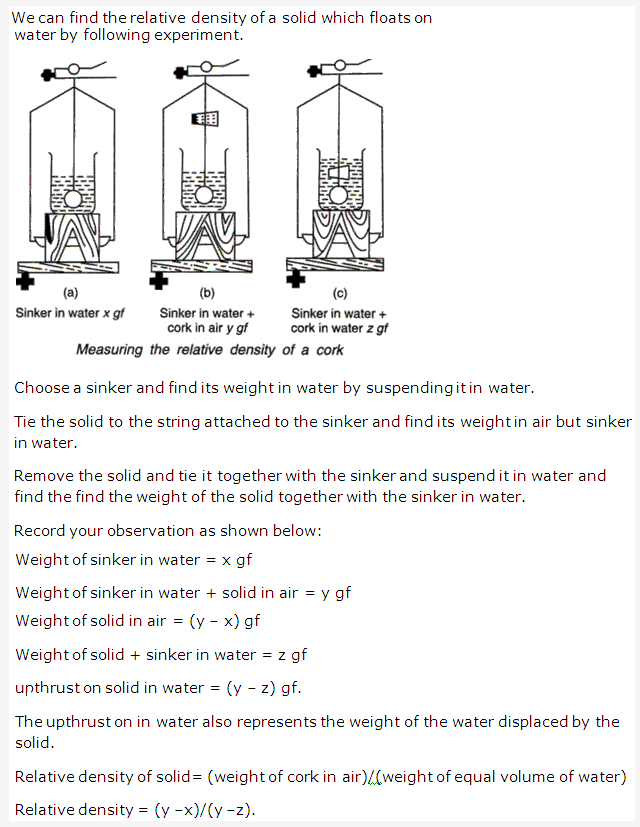
Solution 46:

Solution 47:

Solution 48:
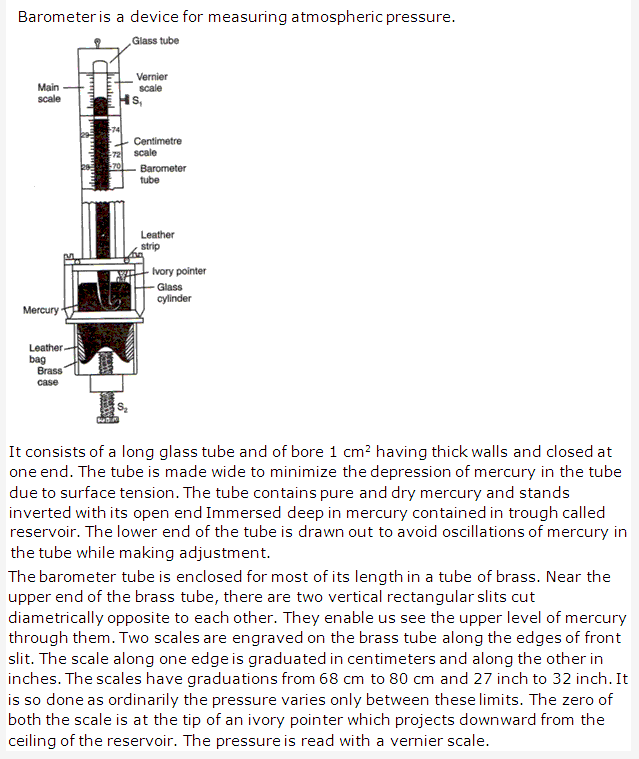
Solution 49:
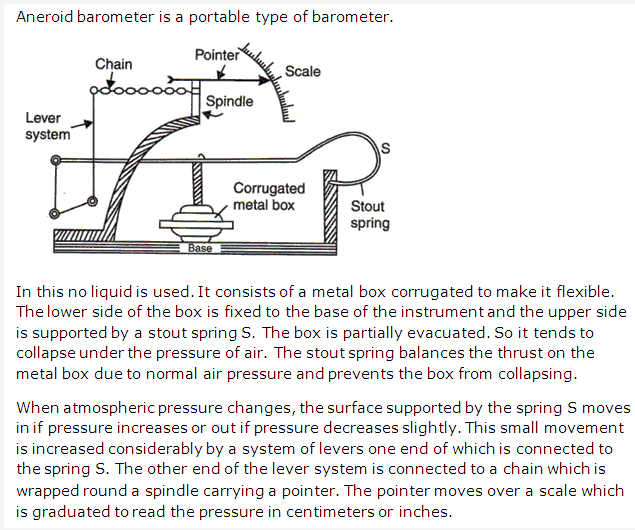
Solution 50:
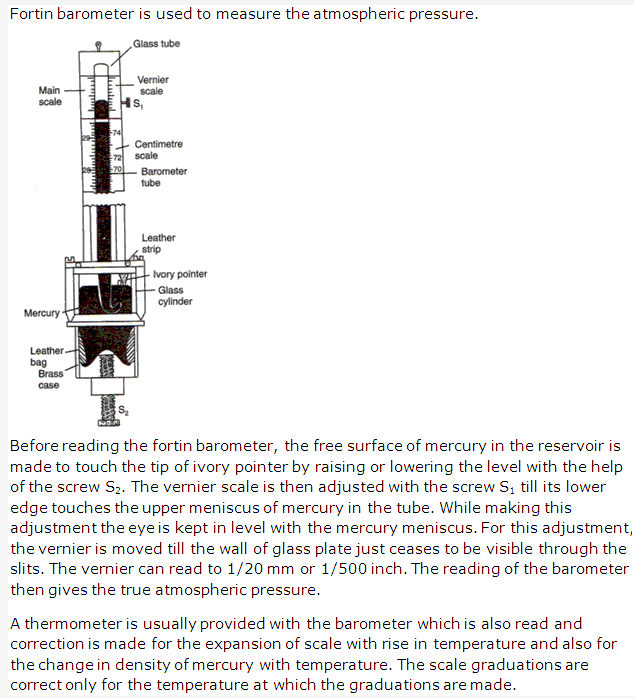
Solution 51:

